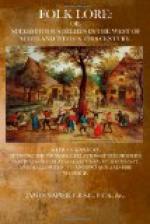Tennant, in his Tour through Scotland, states that farmers placed boughs of the mountain ash in their cow-houses on the second day of May to protect their cows from evil influences. The rowan tree possessed a wonderful influence against all evil machinations of witchcraft. A staff made of this tree laid above the boothy or milk-house preserved the milk from witch influence. A churn-staff made of this wood secured the butter during the process of churning. So late as 1860 I have seen the rowan tree trained in the form of an arch over the byre door, and in another case over the gate of the farmyard, as a protection to the cows. It was also believed that a rowan tree growing in a field protected the cattle against being struck by lightning.
Mr. Train describes the action of a careful farmer’s wife or dairymaid thus:—
“Lest witches should obtain
the power
Of Hawkie’s milk in
evil hour,
She winds a red thread round
her horn,
And milks thro’ row’n
tree night and morn;
Against the blink of evil
eye
She knows each andidote to
ply.”
The same author, writing in 1814, says:—“I am acquainted myself with an Anti-Burgher clergyman who actually procured from a person who pretended to such skill in these charms two small pieces of carved wood, to be kept in his father’s cow-house as a security for the health of his cows.” The belief in the potency of the rowan tree to ward off evil is no doubt a survival of ancient tree worship. Of this worship, the Rev. F.W. Farrar says:—“It may be traced from the interior of Africa, not only in Egypt and Arabia, but also onwards uninterruptedly into Palestine and Syria, Assyria, Persia, India, Thibet, Siam, the Philippine Islands, China, Japan, and Siberia; also westward into Asia Minor, Greece, Italy, and other countries; and in most of the countries here named it obtains at the present day, combined, as it has been, in other parts with various forms of idolatry.” Were it our object, it could also be shown that tree worship has been combined with Christianity. The rowan tree was held sacred by the Druids, and is often found among their stone monuments. There is a northern legend that the god of thunder (Thor), when wading the river Vimar, was in danger of being swept away by its current, but that, grasping a tree which grew on the bank, he got safely across. This tree was the mountain ash, which was ever after held sacred; and when these nations were converted to Christianity, they did not fall away from their belief in the sanctity of the rowan tree.
Not many years ago, I was told of a miraculous make of butter which was reported to have occurred in the west of Lanarkshire a short time before. One morning, a farmer’s wife in that district and her maid-servant wrought at the kirn, but, do as they would, no butter would appear. In this dilemma, they sat down to consider about the cause, and then they recollected that a neighbouring woman had come




